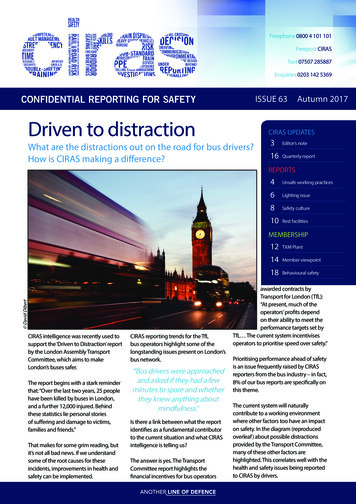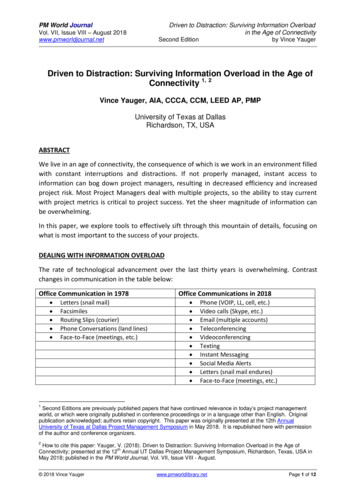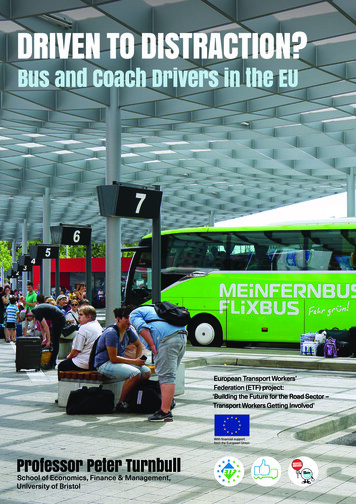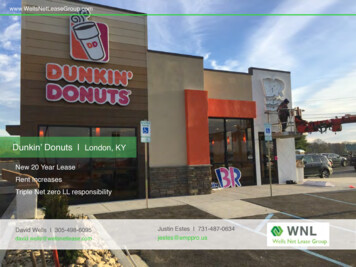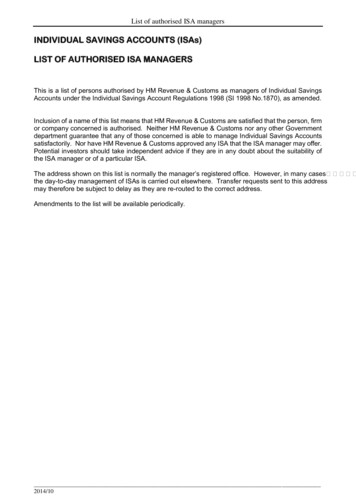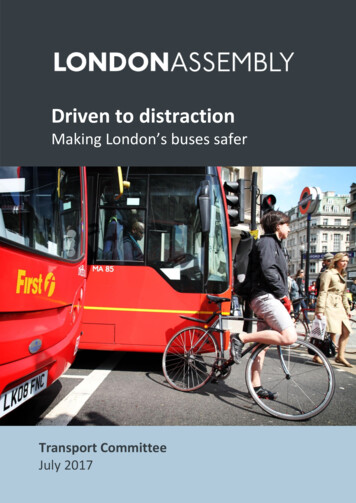
Transcription
Driven to distractionMaking London’s buses saferTransport CommitteeJuly 2017
Holding the Mayor toaccount andinvestigating issues thatmatter to Londoners
Transport Committee MembersCaroline PidgeonMBE AM(Chair)Liberal DemocratKeith Prince AM(Deputy Chair)ConservativeDavid Kurten AMUKIPJoanneMcCartney AMLabourShaun Bailey AMConservativeSteve O’ConnellAMConservativeTom Copley AMLabourCaroline RussellAMGreenFlorence EshalomiAMLabourNavin Shah AMLabourThe Transport Committee holds the Mayor and Transport for London toaccount for their work delivering the capital’s transport network. Thecommittee examines all aspects of the transport network and presses forimprovements on behalf of Londoners.ContactGeorgina Wells, Assistant Scrutiny ManagerEmail: scrutiny@london.gov.ukContact: 020 7983 4000Follow ondon.assembly
ContentsForeword . 4Summary . 6Recommendations . 91.Introduction . 122.Incentivising safety . 153.Under pressure . 224.Driver training . 315.Vehicle safety. 356.Incident reporting and investigations . 397.The Bus Safety Programme . 44Appendix 1 . 47Appendix 2 . 48Our approach . 49References . 51Other formats and languages . 53London Assembly I Transport Committee3
ForewordCaroline Pidgeon MBE AMChair of the Transport CommitteeOver the last two years, 25 people have been killed bybuses in London, and a further 12,000 injured. Behindthese statistics lie personal stories of suffering anddamage to victims, families and friends. We cannotallow this to continue. Through our investigation, wehave tried to get to the root causes of these incidentsand identify how Transport for London (TfL) canprevent them in the future.In many ways, it is clear that the bus service in London has improveddramatically in recent years. TfL and the operators have worked hard todesign and deliver a bus network that passengers can rely on. But attentionseems to have slipped away from safety during this time and TfL’s mantra‘safety is our top priority’ appears not to be the reality. Instead, TfLencourages bus operators to make punctuality their top priority. Throughtheir contractual agreements with TfL, operators are under great financialpressure to meet tight time targets, with the strain ultimately borne by busdrivers.If TfL wants to instil a culture of safety in the operation of the bus network ithas to give operators the right kinds of incentives. Prioritising safety mightmean buses are driven more slowly and journeys may take longer. It couldalso mean more drivers are needed to allow for shorter shifts and longerbreaks. It is for the Mayor and TfL’s board to decide if this is worth theadditional cost.During this investigation, it has become clear that London’s bus drivers do atough job, and work in conditions that other Londoners probably don’tappreciate. Shifts are long and drivers can be working for up to 16 hours at atime, with short breaks planned that can’t always be taken when buses runbehind schedule. Long periods of intense concentration and a system run onstressful, barely achievable time targets inevitably have consequences forsafety.The Mayor has already committed to improving conditions for bus drivers andworking towards a Vision Zero ambition for road safety. The targets for bussafety in the draft Transport Strategy are welcome, but it will requiredetermination on all sides if they are to be achieved. TfL can, and must,refocus its resources on making the network safer.London Assembly I Transport Committee4
This has been a fascinating and timely investigation. Whilst there is goodpractice and innovation across the bus industry and TfL, it must go further.The current situation is just not acceptable and we urge TfL to consider ourrecommendations and act quickly to improve the safety of London’s buses. Onbehalf of the committee I would like to extend my thanks to all those whohave contributed to this report: to TfL, those involved in bus collisions, the busoperators, controllers, and not forgetting the drivers of London’s buses.London Assembly I Transport Committee5
SummaryMillions of people rely on London’s buses every day, and TfL has made greatprogress in improving the reliability and punctuality of the service over thelast decade. But TfL needs to do more to improve the safety of the busnetwork. Depending on which statistics you use, injury and collision rates onLondon’s buses are not improving and may actually be getting worse. This ishugely concerning, and we conclude that TfL’s focus on journey time reliabilityis a major factor. While we applaud TfL’s efforts to improve reliability andattract more people to use buses, this must not be at the expense of safety.We are pleased that the draft Transport Strategy proposes bus safety targetsfor the first time, with the ultimate aim of eliminating bus fatalities by 2030.But our investigation has revealed weaknesses in TfL’s approach to bus safetythat need to be addressed if significant improvement is to be made.Incentivising safetyTfL contracts out its bus services to a number of operators, and the financialincentives in those contracts are the key driver for how operators work. This,in turn, dictates the behaviour of bus drivers. At present, much of theoperators’ profits depend on their ability to meet the performance targets setby TfL. Recent improvements in bus reliability are proof that these financialincentives work. Yet there are no safety targets in these contracts. TfL cannotrealistically expect bus operators to give safety the priority it deserves withoutfinancial reward. If anything, the current system incentivises operators toprioritise speed over safety. This has to change. TfL also needs to lookinwards. At the moment, TfL’s senior management bonuses are not linked tosafety metrics, though they are linked to other metrics like profit andreliability. We want TfL to change this, and give safety an appropriateweighting in its performance bonus system.Contracts to operate London’s bus routes are tendered on a route-by-routebasis, with TfL awarding route contracts based on the bids they receive and itsown analysis of each operator’s performance. This keeps operationcompetitive, which is likely to help keep performance standards up. But it alsofosters variation within key elements of the service, as operators make theirown decisions about things like incident management, control centreoperations and staff training. It is conceivable that this lack of consistency hassafety implications. Competition for route contracts means operators outbidone another in order to provide TfL with the most competitive offer. There issome evidence that operators’ feel the need to make unrealistic (andpotentially unsafe) cuts to their services in order to win route contracts. WhileTfL needs to remain competitive and secure a good price for these contractualservices, it must not be at the expense of safe operation.In order to set appropriate incentives, TfL needs to improve the data it uses tomeasure bus safety. It currently uses a number of data sets, which don’tLondon Assembly I Transport Committee6
always align. TfL needs to combine the data sets in a way that makes thisinformation more useful as a performance measure, and easier for the publicto understand. This isn’t a straightforward task and we appreciate thecomplexity involved. Nevertheless, improving safety data is vital if TfL is to beheld properly to account, and for bus operators to be incentivised to makesafety a priority.Supporting bus driversLondon bus drivers have a very challenging job, and juggle a wide range oftasks during the course of their day. We are concerned that the working dayfor drivers is too long and that drivers do not get the rest breaks they need.This is leading to high levels of stress and fatigue that increase the risk ofcollisions. We do not think that either TfL or bus operators are doing enoughto support bus drivers. While the operators are directly responsible fordrivers’ working conditions, we think TfL needs to take a much more proactive role to determine how to improve conditions.The safety training provided to bus drivers is inconsistent and insufficient.Operators remain largely responsible for driver safety training, and trainingstandards are inconsistent across London and even within individualcompanies and garages. Furthermore, the classroom training and officialguidance doesn’t prepare drivers for the real-world conditions theyexperience on the road. While safety training that is route or area specific isbest conducted by operators, TfL should introduce London-wide safetytraining that is delivered to all bus drivers. TfL also needs to commit todelivering all driver safety training on a rolling basis, so that standards aremaintained.Making buses saferTfL is developing a new Bus Safety Standard (BSS) to use technology to makebuses safer. This is welcome, and many have told us how significant an impactthey expect new safety technology like Intelligent Speed Adaptation andAutomatic Electronic Braking to have. But the BSS has been delayed and buseswill not be fitted with the new technology until winter 2018. While weunderstand TfL’s desire to get the BSS right, this is a significant delay that ishaving serious consequences on our roads. TfL needs to work faster tointroduce these potentially life-saving technologies and bring down the injuryand collision rates as quickly as possible. It also needs to consider the benefitsof retro-fitting the standard’s requirements on the entire fleet.Many drivers told us about their concerns regarding the maintenancestandards across London’s bus fleet. They feel their vehicles are kept in anunacceptable state of repair, and blame it on ‘belt tightening’ and a shortageof engineers. TfL needs to assess the scale of this problem and, if necessary,come up with a strategy to tackle it.London Assembly I Transport Committee7
Incident reporting and investigationsBus drivers need to feel they can raise health and safety issues withmanagement and their concerns will be properly addressed. Any publictransport network needs a good reporting process for all employees, butmany of London’s bus drivers are not comfortable raising concerns with theiremployers. For the last year, bus drivers have had access to an incidentreporting process in the form of the Confidential Incident Reporting andAnalysis System (CIRAS). But many bus drivers don’t know how to use thissystem yet, and some are put off using it because they believe they have toraise concerns with operators first.Improvements need to be made to the way that incidents involving injuries orfatalities are investigated. TfL has recently made a number of improvementsto the way that serious incidents are investigated, and we welcome thisprogress. However, it’s still the case that when a person dies as a result of aLondon bus incident, there is no impartial transport body to investigate whathappened. This must change. When a rail incident occurs in the UK, such asthe devastating tram derailment in Croydon last year, two impartial bodies –the Rail Accident Investigation Branch and the Office of Rail and Road – set uptheir own investigations (alongside those of the British Transport Police andothers). Public transport on the road must have the same impartialinvestigation procedures as it has on rails.The Bus Safety ProgrammeTfL started the Bus Safety Programme (BSP) in 2016, with the intention to‘drive major improvements in safety across London’s bus network’. While wewelcome any effort to improve safety, we do not think that the BSP willachieve major safety improvements in its current form. It does not tacklemany of the key safety issues we have identified in this investigation and itneeds to be significantly strengthened. We call for the BSP to be revised inlight of this report.It is in TfL’s power to put bus safety firmly at the top of its agenda. Prioritisingsafety might mean services running more slowly. It might mean hiring morebus drivers. Both of these might mean additional costs, and we recognise thedifficult financial situation facing TfL. But the bus service is the backbone ofLondon’s transport system, carrying millions of Londoners every day. Thesejourneys must be safe, above all else.London Assembly I Transport Committee8
RecommendationsRecommendation 1TfL should set safety targets for bus operators. Wesuggest the best way to do this is to integrate safetytargets in the QICs performance target structure as soonas possible. If safety performance targets are adopted,the proposed safety scorecard may be redundant andTfL could consider ceasing work to develop it. TfL shouldwrite to the committee, setting out how it will take thisforward by the end of October 2017.Recommendation 2IncentivisingsafetyTfL should revise its senior staff bonus scheme tointroduce a direct link between bus safety andperformance-related payments. TfL should write to thecommittee, setting out how it will take this forward bythe end of October 2017.Recommendation 3By the end of October 2017, TfL should set out the stepsit will take to improve the data it uses for bus safetyanalysis and trend reporting, in response to this report.This should include: amalgamation of STATS19 and IRIS data setsmore accurate reporting of long-term buscollision and injury trendsRecommendation 4Under pressureTfL should commission a comprehensive andindependent investigation or piece of research intoLondon bus drivers’ working conditions (with a focus onthe causes of fatigue) in order to determine the scale ofthe problem. This should involve setting up workinggroups and surveying drivers as well as others who canoffer different perspectives, such as controllers,mechanics and other operational staff.The report should be made public and any findingsshould feed into the proposed revision of the Bus SafetyProgramme.London Assembly I Transport Committee9
Recommendation 5*TfL should undertake additional work with the operatorsto try and reduce the number of distractions facingdrivers. This could include: Under pressure work to understand the extent to whichdistracting maintenance issues go unresolved(such as faulty wing mirrors or wipers) andconsideration of how to speed up maintenanceworks in garages.a commitment to deliver a toilet on each busroute (available at all times that the bus is inservice) by the end of 2018a review of radio contact procedures anddevelopment of guidelines or best practiceprinciplesa review of best practice for bus infrastructureand design. This should include bus laneinstallation, bus stop siting and consideration ofthe impact other infrastructure, like parkingbays, has on the driver’s ability to navigate theroute safelyTfL should write to the committee, setting out how itwill take this forward by the end of October 2017.Recommendation 6Driver trainingTfL should take responsibility for delivering driver safetytraining, as it has for customer service training. TfLshould develop a new safety training package, based onclose consultation with the operators and bus drivers.This training should be delivered on a rolling basis andcould form part of the mandatory 35 training hours thatdrivers must complete every 5 years.Recommendation 7TfL should commit to a publication date for the BusSafety Standard. TfL should also undertake acost/benefit analysis for retrofitting the entire bus fleetwith BSS technology.Vehicle safetyRecommendation 8TfL should conduct a review of bus maintenancepractices in garages. It should also carry out work tounderstand the scale of the bus engineer shortage inLondon Assembly I Transport Committee10
London and develop measures to tackle it.TfL should write to the committee, setting out how itwill take this forward by the end of October 2017.Recommendation 9TfL should tackle the barriers drivers face accessingCIRAS – the confidential incident reporting service. TfLshould communicate information about CIRAS to alldrivers by embedding it in safety training and monitorits use through driver surveys.TfL should write to the committee, setting out how itwill take this forward by the end of October 2017.Incidentreporting andinvestigationsRecommendation 10TfL should carry out a review into how bus incidents areinvestigated in London. In particular, it should consider: whether serious incidents should be investigatedby an independent body, as occurs in the railindustryhow to make incident reporting more consistentbetween operatorshow to ensure that lessons are learned from allincident investigations and shared between alloperatorsTfL should write to the committee, setting out how itwill take this forward by the end of October 2017.Recommendation 11The Bus SafetyProgrammeTfL should publish an update on the Bus SafetyProgramme in January 2018. This should draw onlearnings from the first two years of the BSP and addressthe issues and recommendations contained in thisreport.* David Kurten AM, UKIP, would like to note the following:It is my view that the review of best practice for bus infrastructure and designcalled for in Recommendation 5 should be expanded to include considerationof the impact of cycle lanes and cycle superhighways.London Assembly I Transport Committee11
1. IntroductionKey findings Millions of people rely on London’s buses every day,though passenger numbers have fallen recently. TfL provides London with an excellent bus servicewhich has improved in many ways in recent years. By some measures, injury and collision rates are notimproving and may be worsening. Our investigation has examined the causes ofinjuries and collisions and identified potentialsolutions.London Assembly I Transport Committee12
1.1After walking, buses are the most heavily used form of transport in London. In2016, buses took passengers on 2.3 billion journeys and travelled 492 millionkilometres in London.1&2 TfL provides London with an excellent bus servicethat has improved in many ways in recent years – it carries more passengers,at a higher frequency, and more reliably than 10 years ago – despiteworsening congestion on the roads. But TfL needs to do more to improve thesafety of the bus network. During the course of our investigation, a man waskilled on Oxford Street after being hit by a bus.3 In 2015 and 2016, 25 peoplewere killed on, or by, buses. Two thirds of those killed were pedestrians.4Nearly 12,000 others were injured on-board or in incidents with buses duringthis period: 5,700 in 2015 and 6,100 in 2016.51.2Bus passengers are more likely to be injured in a bus incident than any otherroad user. The most common cause of injury is “slips, trips or falls” (Figure 1).6Sharp braking and other poor driving practices are likely to cause theseinjuries. The passenger survey we undertook reflects this – 55 per cent ofrespondents said they had experienced sharp braking on their bus in the lastmonth.7 Nearly as many had experienced acceleration that they consideredto be too sharp.Figure 1: Most injuries in 2016 were from slips, trips and falls1.3London does not compare well with other major cities on its record for bussafety. Of the 15 world cities measured by the International BusBenchmarking Group (IBBG), London was one of only five not to haveimproved since 2007, and was ranked fifth-worst for safety in 2014.81.4In carrying out this investigation we have looked at the causes of bus collisionsand injuries. We have examined a wide range of factors, including contractualarrangements between TfL and the bus operators, performance targets, drivertraining, working conditions, bus maintenance, vehicle technology andincident reporting processes. We have also assessed the first year of TfL’s newBus Safety Programme (BSP), launched in February 2016.1.5The Committee has engaged with many individuals and organisations as partof this investigation, including TfL, bus operators, bus drivers, safetycampaigners and passengers. We are very grateful for their contributions, andLondon Assembly I Transport Committee13
expect TfL to respond to this report constructively to improve bus safety foreveryone in London.London Assembly I Transport Committee14
2. Incentivising safetyKey findings TfL needs to introduce headline injury and collisionreduction targets so that operator progress can bemeasured. TfL’s contracts with bus operators do not incentivisesafety and should be revised. TfL’s senior management bonuses should be linkedto safety, as they already are for other metrics likereliability and profit. TfL should improve bus safety data by combiningdifferent data sets to more accurately identifytrends.London Assembly I Transport Committee15
Setting safety targets2.1The Mayor sets TfL targets for improving general road safety. However, untilthe recent publication of the Mayor’s draft Transport Strategy, there were nospecific targets for bus safety in London. The Mayor has now proposed atarget in his draft strategy to eliminate deaths on, or caused by, buses by 2030and an interim target to reduce the number of people killed or seriouslyinjured in, or on, London buses by 70 per cent against 2005-09 levels, by2022.92.2Injury and collision targets could be used to provide TfL and operators withclear incentives to improve London’s bus safety record. They have a clear rolein improving performance for many private and public services. As we explorein this chapter, performance targets have helped TfL drive up the reliability ofthe bus network in recent years. We believe that a similar approach could alsobe applied to bus safety by directly linking safety performance to profits for allbus operators working in London, and to the pay of senior TfL management.2.3TfL has told us that it intends to introduce bus safety targets, but there is noindication that they would be linked to financial incentives. In November2016, TfL’s Safety, Sustainability and Human Resources Panel was asked toagree a bus customer major injury target for 2017/18.10 TfL also told us inFebruary that it would aim to set bus safety targets by the end of the year.11We are waiting for TfL to publish these targets, but we think that they need tobe linked to financial incentives if they are to be effective.Bus operator contracts2.4TfL pays private bus companies to operate bus services in London. Theamount each operator receives is determined by its ability to meet theperformance criteria set by TfL in its Quality Incentive Contract (QIC) – inparticular, bus reliability. According to the operators, these QIC bonuses arecritical to their ability to make a profit.12 The incentive to keep buses runningon time is therefore clearly high.2.5QICs – and the priority they give to bus reliability – are credited with helpingdrive up bus performance in London over the last decade. TfL has designedthese QICs with the passenger in mind: surveys have repeatedly shown thatpassengers are most concerned with service reliability. We agree that, inorder to attract people out of cars, public transport has to provide a reliablealternative. However, during the course of this investigation, we becameincreasingly concerned that the contractual focus on reliability may be puttingthe safety of Londoners at risk.London Assembly I Transport Committee16
Improving bus performance through Quality Incentive ContractsQuality Incentive Contracts were introduced by TfL in 2001 and have beencredited with delivering significant improvements in service quality andpassenger numbers. They contain incentives for bus operators in the form ofreliability performance payment bonuses and deductions, together with theoption of a two-year contract extension from five to seven years.For each bus route, operators receive an annual reliability performancepayment which is calculated by comparing the reliability level achievedagainst the Minimum Performance Standard set out in the contract.2.6TfL has previously explained its decision not to set safety targets for theoperators by stating that:[safety] is not directly related to payments/deductions due to theimportance of avoiding the suggestion that safety of operation isin any way a negotiable trade off against cost.13While we understand TfL’s argument, we fundamentally disagree with it.Operators will behave in line with the incentives (particularly the financialones) that are set by TfL – their shareholders would expect nothing less. Bynot factoring safety into the payment structure of contracts, TfL is failing todirect operators to provide the safe service we think London needs. As thecase study below illustrates, financial payments have been successfully linkedto safety in transport contracts in other countries.Case study – using financial incentives to make Spanish roads safer14Contractual incentives relating to safety have been used in public-privatepartnerships used to manage road infrastructure on some Spanish highwaysfor more than a decade. These incentives take two forms – either anextension to the contract period, or a financial payment to the road operator.According to research:The implementation of safety incentives in public privatepartnerships has a positive influence in the reduction of fatalities,injuries and accidents.15Highways managed through contracts including these incentives had 65 percent fewer collisions per million vehicle-kilometres than highways withoutthose incentives.2.7If TfL wants to take positive steps to reduce injury and collision rates, it mustintroduce meaningful incentives for operators to make their services safer.Londoners agree with us: of the 1,662 Londoners we surveyed, 88 per centthought it was important that TfL incentivised safety as well as punctuality.162.8In response to this report, we expect TfL will point to the future introductionof a new safety scorecard. This will measure operator performance andcontribute to the awarding or denying of route contract extensions andLondon Assembly I Transport Committee17
subsequent new contracts. It will also provide information that TfL will use inreview meetings with bus operators. We welcome this development and thescorecard will be some improvement on the current situation. However, TfLhas not proposed that the scorecard will be linked in any way to financialreward for the operators, who we expect will continue to prioritise theircontractual obligations (and financial rewards) in terms of bus reliability.2.9TfL therefore needs to go a step further, and incentivise safety in its buscontracts alongside reliability. We are not in a position to recommend exactlyhow TfL should introduce safety-related payments into its contracts – that isfor TfL to consider in conjunction with its other incentives.Recommendation 1TfL should set safety targets for bus operators. We suggest the best way todo this is to integrate safety targets in the QICs performance targetstructure as soon as possible. If safety performance targets are adopted,the proposed safety scorecard may be redundant and TfL could considerceasing work to develop it. TfL should write to the committee, setting outhow it will take this forward by the end of October 2017.Incentivising senior staff2.10 One way of focusing minds at the very top of an organisation is throughperformance-related pay. TfL already uses this approach for the pay of itssenior staff, who can earn large bonuses if they meet agreed performancestandards: up to 50 per cent of base pay for the Commissioner, up to 30 percent for Managing Directors and up to 20 per cent for Directors. Bonuses arecalculated with reference to performance against a matrix of TfL-wideobjectives, business group objectives and personal objectives.2.11 TfL’s current bonus scheme does not effectively reward improvements in bussafety.17 The bonus scheme for TfL’s Surface Transport directorate (whichincludes buses) has a set of 17 measures which are weighted to make up thebusiness group element of the bonus payment.18 These measures include fivemost relevant to buses (such as bus customer satisfaction, bus excess waittime and KSIs on London’s roads across all transport modes), but we thinkthat these do not provide sufficient incentive for senior managers to focus onbus safety.2.12 As with the bus operator contracts, TfL’s staff bonus scheme therefore fails togive bus safety the priority it needs. In view of the fact that the bonus schemefor London Underground includes a metric for ‘significant injuries per millionhours on rail and underground’, the bonus scheme for the Surface Transportdirectorate and the Commissioner needs to be updated to include a specificmeasure for bus safety. 19London Assembly I Transport Committee18
Recommendation 2TfL should revise its senior staff bonus scheme to introduce a direct linkbetween bus safety and performance-related payments. TfL should writeto the committee, setting out how it will take this forward by the end ofOctober 2017.Safety data2.13 If TfL is to link bus safety to operator contracts or its own performance-relatedpay, it will need better data than it currently has. It is worth noting that TfLhas committed to improving the information
Driven to distraction Making London’s buses safer Transport Committee July 2017 . Holding the Mayor to account and investigating issues that . tough job, and work in conditions that other L
